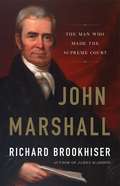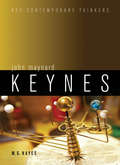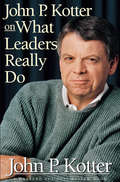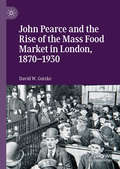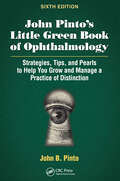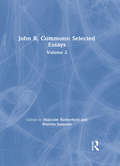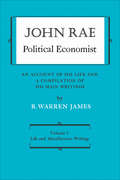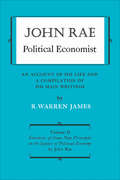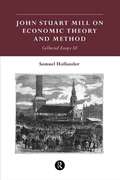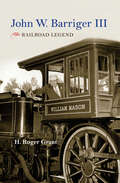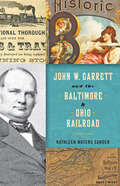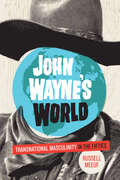- Table View
- List View
John M. Case Co.
by Samuel L. HayesThe owner of a small, privately held company decides to sell out, and a group of the company's top managers structures a leveraged buyout. A rewritten version of an earlier case.
John Mackey and Whole Foods Market
by Katherine Miller Nancy F. KoehnTraces the history of organic agriculture from its pre-industrial roots to the present day, and examines the growth of Whole Foods Market in the context of the broader growth of the organic industry. Also investigates John Mackey's role as a founder and leader of the largest natural-foods retailer in the world.
John Marshall: The Man Who Made the Supreme Court
by Richard BrookhiserThe life of John Marshall, Founding Father and America's premier chief justice In 1801, a genial and brilliant Revolutionary War veteran and politician became the fourth chief justice of the United States. He would hold the post for 34 years (still a record), expounding the Constitution he loved. Before he joined the Supreme Court, it was the weakling of the federal government, lacking in dignity and clout. After he died, it could never be ignored again. Through three decades of dramatic cases involving businessmen, scoundrels, Native Americans, and slaves, Marshall defended the federal government against unruly states, established the Supreme Court's right to rebuke Congress or the president, and unleashed the power of American commerce. For better and for worse, he made the Supreme Court a pillar of American life. In John Marshall, award-winning biographer Richard Brookhiser vividly chronicles America's greatest judge and the world he made.
John Maynard Keynes (Key Contemporary Thinkers)
by M. G. HayesJohn Maynard Keynes is the 20th century’s greatest economist. He sparked an intellectual revolution that transformed economic theory and policymaking. This book, written in plain English with minimal mathematics, is a concise and probing account of his major ideas. Keynes, argues Mark Hayes, showed that economics is a science of thinking in terms of models, in which progress depends on recognising when established models have become obsolete and new ones are required. Hayes outlines how Keynes did this, tracing his progression from the ‘Classical’ model that he inherited through to his masterpiece, The General Theory of Employment, Interest and Money, and beyond. The intellectual narrative is placed in its historical context, from the Versailles Peace Conference in 1919 to Bretton Woods. The final chapters consider the impact of Keynes’s legacy, including his relevance to reform of the Euro. This accomplished study is not only a comprehensive introduction for students and general readers, but also a crystal-clear demonstration of how Keynes’ thought is vital to understanding why contemporary economics needs to discard its old models and embrace profound change.
John Maynard Keynes and the Economy of Trust: The Relevance of the Keynesian Social Thought in a Global Society
by Donatella PaduaPadua has asked the question: How is it possible to build value via trust? She has answered through the construction of a compelling argument for the creation of a balanced global economy and a fairer distribution of wealth based upon that elusive quality of trust. - Garry Titterton, Tonjin University, Shanghai, Co-author Brand Storming.
John P. Kotter on What Leaders Really Do
by John P. KotterA Harvard Business Review Book. Widely acknowledged as the world's foremost authority on leadership, John Kotter has devoted his remarkable career to studying organizations and those who run them, and his bestselling books and essays have guided and inspired leaders at all levels. Here, in this collection of his acclaimed Harvard Business Review articles, is an astute assessment of the real work of leaders, as only John Kotter can offer. To complement the HBR articles, Kotter also contributes a new piece, a thoughtful reflection on the themes that have developed throughout his work. Convinced that most organizations today lack the leadership they need, Kotter's mission is to help us better understand what leaders--real leaders--do. True leadership, he reminds us, is an elusive quality, and too often we confuse management duties and personal style with leadership, or even mistake unworthy leaders for the real thing. Yet without leadership, organizations move too slowly, stagnate, and lose their way. With John Kotter on What Leaders Really Do, readers will learn how to become more effective leaders as they explore pressing issues such as power, influence, dependence, and strategies for change.
John Pearce and the Rise of the Mass Food Market in London, 1870–1930
by David W. GutzkeAt the center of sweeping change to food retailing practices in Victorian and Edwardian England lies one man: John Pearce. An innovative businessman and a quintessential rags-to-riches success story, Pearce was at the forefront of the rise of the mass food market in London. With his catering company Pearce & Plenty, he fed millions of workers who wanted fast, nutritious, and tasty food. David W. Gutzke mines a wide range of primary sources to offer a portrait of a pivotal figure in London and a leader of the temperance catering movement who had “done more than can be readily recognised to render London a sober city.” By studying Pearce’s companies as well as those of his competitors, this book documents a half century of changing consumption habits in London.
John Pinto’s Little Green Book of Ophthalmology: Strategies, Tips and Pearls to Help You Grow and Manage a Practice of Distinction
by John B. PintoThe classic reference text for surgeons and managers alike that has been improving ophthalmic practices for decades, John Pinto’s Little Green Book of Ophthalmology: Strategies, Tips, and Pearls to Help You Grow and Manage a Practice of Distinction, Sixth Edition, has been updated into a new edition. Author John B. Pinto, a world-renowned expert on the business of ophthalmic practice, has brought his decades of expertise to bear in this comprehensive guide to practice management. Inside, Pinto covers everything from the basics of business planning to esoteric and complex topics unique to ophthalmology. Topics include: Strategic business planning Leadership, governance, and discipline Finance, accounting, and patient accounts management Staff evaluation, training, and supervision Marketing and development Managing physicians Operations enhancement Facility design and management Improving an optical dispensary This Sixth Edition features updates and edits throughout the book as well as 9 new appendices covering the latest trends and advice in ophthalmic administration. It is also designed in a flexible format, allowing readers to read it straight through, or just hunt down advice on the focused problems facing their practice. As the business of ophthalmology continues to change, the proven guidance of John Pinto’s Little Green Book of Ophthalmology, Sixth Edition, will help any practice adapt and thrive.
John R. Commons: Selected Essays
by Malcolm Rutherford Warren J. SamuelsFirst published in 2004. Routledge is an imprint of Taylor & Francis, an informa company. John R Commons is one of the most significnat figures in the development of American economics. One of the founders of the institutional school, Commons developed theories which continue to influnece the evolution of capitalsim and of instituitional change. These volumes collect for the first time, his major essays and articles.
John R. Commons: Selected Essays
by Malcolm Rutherford Warren J. SamuelsJohn R. Commons is one of the most significant figures in the development of American economics. One of the founders of the Institutional school, Commons developed theories of the evolution of capitalism and of institutional change which continue to influence modern economics. These volumes collect, for the first time, his major essays and articles.
John R. Commons: Selected Essays
by Malcolm Rutherford Warren J. SamuelsJohn R. Commons is one of the most significant figures in the development of American economics. One of the founders of the Institutional school, Commons developed theories of the evolution of capitalism and of institutional change which continue to influence modern economics. These volumes collect, for the first time, his major essays and articles.
John Rae Political Economist: Life and Miscellaneous Writings
by John Rae R. Warren JamesVolume I contains a biographical study of John Rae, a brilliant economist and scholar who lived in Canada for a period in the early part of the nineteenth century, an analysis of Rae's contributions to economics, and a collection of his articles and essays on a variety of topics. These miscellaneous writings, many of which originally appeared in contemporary newspapers and magazines, reveal the broad range of his intellectual interests as well as his polemic and literary skill. Volume II is a reprint of Rae's book Statement of New Principles on the Subject of Political Economy which was originally published in Boston in 1834. As a result of the reissue of this book, which has been scarce for some years, modern students of economics will be better able to appreciate Rae's fundamental contribution to the development of economic thought, particularly the theory of capital. Much of Rae's analysis of economic development and behaviour was based on a first-hand knowledge of the Canadian economy in the early nineteenth century, but his theory has a surprisingly modern flavour, and is completely relevant to the problems of primitive or emerging economies today. Rae, personally, has been a neglected and obscure figure and one of the main objects of this work is to throw additional light on his career. There were a number of gloomy and disappointing episodes in his life, but, despite them, his devotion to scholarly pursuits remained unimpaired, and his literary output continued throughout his life. This work should appeal to all those interested in the history of ideas, particularly to those concerned with the economic, political and religious controversies of the first half of the nineteenth century. For his contributions to economic theory John Rae is entitled to a place in the first rank of economists anywhere in the world, and for this reason he deserves the attention of all students of economics and sociology. His work is sprinkled with profound insights into human behaviour and, in addition, he displays a literary style which has seldom been surpassed in the literature of economics.
John Rae Political Economist: Statement of Some New Principles on the Subject of Political Economy (reprinted)
by John Rae R. Warren JamesVolume I contains a biographical study of John Rae, a brilliant economist and scholar who lived in Canada for a period in the early part of the nineteenth century, an analysis of Rae's contributions to economics, and a collection of his articles and essays on a variety of topics. These miscellaneous writings, many of which originally appeared in contemporary newspapers and magazines, reveal the broad range of his intellectual interests as well as his polemic and literary skill. Volume II is a reprint of Rae's book Statement of New Principles on the Subject of Political Economy which was originally published in Boston in 1834. As a result of the reissue of this book, which has been scarce for some years, modern students of economics will be better able to appreciate Rae's fundamental contribution to the development of economic thought, particularly the theory of capital. Much of Rae's analysis of economic development and behaviour was based on a first-hand knowledge of the Canadian economy in the early nineteenth century, but his theory has a surprisingly modern flavour, and is completely relevant to the problems of primitive or emerging economies today. Rae, personally, has been a neglected and obscure figure and one of the main objects of this work is to throw additional light on his career. There were a number of gloomy and disappointing episodes in his life, but, despite them, his devotion to scholarly pursuits remained unimpaired, and his literary output continued throughout his life. This work should appeal to all those interested in the history of ideas, particularly to those concerned with the economic, political and religious controversies of the first half of the nineteenth century. For his contributions to economic theory John Rae is entitled to a place in the first rank of economists anywhere in the world, and for this reason he deserves the attention of all students of economics and sociology. His work is sprinkled with profound insights into human behaviour and, in addition, he displays a literary style which has seldom been surpassed in the literature of economics.
John Ruskin's Political Economy (Routledge Studies in the History of Economics #No.32)
by William HendersonThis volume offers an exciting new reading of John Ruskin's economic and social criticism, based on recent research into rhetoric in economics. Willie Henderson uses notions derived from literary criticism, the rhetorical turn in economics and more conventional approaches to historical economic texts to reevaluate Ruskins economic and social criticism. By identifying Ruskin's rhetoric, and by reading his work through that of Plato, Xenophon, and John Stuart Mill, Willie Henderson reveals how Ruskin manipulated a knowledge base. Moreover in analysis of the writings of William Smart, John Bates Clark and Alfred Marshall, the author shows that John Ruskin's influence on the cultural significance of economics and on notions of economic well-being has been considerable.
John Smithers
by Todd D. JickDescribes an ill-fated effort to institute a total quality program. Using the vantage point of one of the managers selected to be a quality instructor, the case traces the rise and fall of the quality effort during its very brief existence over the course of six months. Allows students to identify many things that can undermine implementation of change: lack of corporate commitment, overly formalized programs, inflated expectations, lack of initial successes, etc. A rewritten version of an earlier case.
John Smithers at Sigtek
by Todd D. JickDescribes an ill-fated effort to institute a total quality program. Using the vantage point of one of the managers selected to be a quality instructor, the case traces the rise and fall of the quality effort during its very brief existence over the course of six months. Allows students to identify many things that can undermine implementation of change: lack of corporate commitment, overly formalized programs, inflated expectations, lack of initial successes, etc.
John Stuart Mill and Freedom of Expression: The Genesis of a Theory (Routledge Studies in Social and Political Thought)
by K.C. O'RourkeThe arguments advanced in the second chapter of On Liberty (1859) have become the touchstone for practically every discussion of freedom of speech, yet the broader development of John Stuart Mill's ideas concerning intellectual liberty has generally been neglected. This work attempts to fill that lacuna by looking beyond On Liberty, in order to understand the evolution of Mill's ideas concerning freedom of thought and discussion.
John Stuart Mill on Economic Theory and Method: Collected Essays III
by Samuel HollanderThis book, the third in the series of Samuel Hollander's essays, covers twelve key studies on the economic theory and method of John Stuart Mill. This volume provides an accessible sourcebook on Mill's relationship with David Ricardo, and the 'Classical School', as well as confirming his relevance for modern economics and for the place of economics
John Trani's First Year
by Hugo E.R. UyterhoevenJohn Trani is Stanley Works' new CEO. This case describes his philosophy, communications, and actions during his first seven months in office, aiming at a major transformation of strategic postures, organizational structure, and company culture.
John W. Barriger III: Railroad Legend (Railroads Past and Present)
by H. Roger Grant“Readers will find in his biography an extraordinary tale of the travails of twentieth-century railroading through the career of this one man.” —The Annals of IowaAfter graduating from the Massachusetts Institute of Technology, John W. Barriger III (1899–1976) started his career on the Pennsylvania Railroad as a rodman, shop hand, and then assistant yardmaster. His enthusiasm, tenacity, and lifelong passion for the industry propelled him professionally, culminating in leadership roles at Monon Railroad, Pittsburgh and Lake Erie Railroad, Missouri-Kansas-Texas Railroad and the Boston and Maine Railroad. His legendary capability to save railroad corporations in peril earned him the nickname “doctor of sick railroads,” and his impact was also felt far from the train tracks, as he successfully guided New Deal relief efforts for the Railroad Division of the Reconstruction Finance Corporation during the Depression and served in the Office of Defense Transportation during World War II. Featuring numerous personal photographs and interviews, John W. Barriger III is an intimate account of a railroad magnate and his role in transforming the transportation industry.“Thanks to Roger Grant’s latest book, Barriger and his amazing legacy endures, waiting to be rediscovered by a new generation of readers. Trust me, you’ll learn a lot.” —Classic Trains“H. Roger Grant’s biography, John W. Barriger III, offers a new and much needed perspective on this prominent individual. Grant brings together an overview of Barriger’s career developments with an appropriate balance of insights into his early life and introduction to railroads.” —Journal of Transport History
John W. Garrett and the Baltimore and Ohio Railroad
by Kathleen Waters SanderHow John W. Garrett and the B&O Railroad he headed for twenty-six years helped to transform America by linking the nation.Chartered in 1827 as the country’s first railroad, the legendary Baltimore and Ohio played a unique role in the nation’s great railroad drama and became the model for American railroading. John W. Garrett, who served as president of the B&O from 1858 to 1884, ranked among the great power brokers of the time. In this gripping and well-researched account, historian Kathleen Waters Sander tells the story of the B&O’s beginning and its unprecedented plan to build a rail line from Baltimore over the Allegheny Mountains to the Ohio River, considered to be the most ambitious engineering feat of its time. The B&O’s success ignited "railroad fever" and helped to catapult railroading to America’s most influential industry in the nineteenth century.Taking the B&O helm during the railroads’ expansive growth in the 1850s, Garrett soon turned his attention to the demands of the Civil War. Sander explains how, despite suspected Southern sympathies, Garrett became one of President Abraham Lincoln's most trusted confidantes and strategists, making the B&O available for transporting Northern troops and equipment to critical battles. The Confederates attacked the B&O 143 times, but could not put "Mr. Lincoln’s Road" out of business. After the war, Garrett became one of the first of the famed Gilded Age tycoons, rising to unimagined power and wealth. Sander explores how—when he was not fighting fierce railroad wars with competitors—Garrett steered the B&O into highly successful entrepreneurial endeavors, quadrupling track mileage to reach important commercial markets, jumpstarting Baltimore’s moribund postwar economy, and constructing lavish hotels in Western Maryland to open tourism in the region. Sander brings to life the brazen risk-taking, clashing of oversized egos, and opulent lifestyles of the Gilded Age tycoons in this richly illustrated portrait of one man’s undaunted efforts to improve the B&O and advance its technology. Chronicling the epic technological transformations of the nineteenth century, from rudimentary commercial trade and primitive transportation westward to the railroads’ indelible impact on the country and the economy, John W. Garrett and the Baltimore & Ohio Railroad is a vivid account of Garrett’s twenty-six-year reign.
John Wayne's World: Transnational Masculinity in the Fifties
by Russell MeeufIn a film career that spanned five decades, John Wayne became a U. S. icon of heroic individualism and rugged masculinity. His widespread popularity, however, was not limited to the United States: he was beloved among moviegoers in Asia, Africa, Latin America, and Europe. In John Wayne’s World, Russell Meeuf considers the actor’s global popularity and makes the case that Wayne’s depictions of masculinity in his most popular films of the 1950s reflected the turbulent social disruptions of global capitalism and modernization taking place in that decade. John Wayne’s World places Wayne at the center of gender- and nation-based ideologies, opening a dialogue between film history, gender studies, political and economic history, and popular culture. Moving chronologically, Meeuf provides new readings of Fort Apache, Red River, Hondo, The Searchers, Rio Bravo, and The Alamo and connects Wayne’s characters with a modern, transnational masculinity being reimagined after World War II. Considering Wayne’s international productions, such as Legend of the Lost and The Barbarian and the Geisha, Meeuf shows how they resonated with U. S. ideological positions about Africa and Asia. Meeuf concludes that, in his later films, Wayne’s star text shifted to one of grandfatherly nostalgia for the past, as his earlier brand of heroic masculinity became incompatible with the changing world of the 1960s and 1970s. The first academic book-length study of John Wayne in more than twenty years, John Wayne’s World reveals a frequently overlooked history behind one of Hollywood’s most iconic stars.
Johnson & Johnson (A)
by Francis J. Aguilar Arvind BhambriDescribes the Johnson & Johnson culture and the corporate systems, structures, and procedures which reflect and promote it. The principal teaching objectives are to gain an understanding of the impact a strong culture can have on strategic decisions and to consider how such cultures might be managed.
Johnson & Johnson (B): Hospital Services
by Francis J. Aguilar Arvind BhambriThe main issue has to do with the lack of fit or incompatibility between the early environmental requirements for strategy and the cultural constraints on the organization. Describes the internal resistance to the proposed changes and top management's efforts to resolve the contradictory requirements of strategy and culture. A second major issue concerns the challenge facing a general manager who has been given responsibility for operationalizing the forced solution.
Johnson & Johnson: Hospital Services
by Andrall E. Pearson Johanna M. HurstakThe main issue has to do with the lack of fit or incompatibility between the early environmental requirements for strategy and the cultural constraints on the organization. Describes the internal resistance to the proposed changes and top management's efforts to resolve the contradictory requirements of strategy and culture. A second major issue concerns the challenge facing a general manager who has been given responsibility for operationalizing the forced solution. Provides a brief background on Johnson & Johnson culture and the corporate systems and structures. A consolidated version of two earlier cases.

